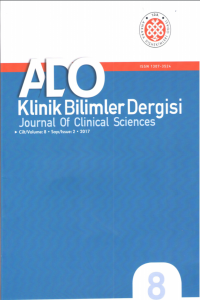Sürmüş Meziyodensler
Meziyodens, Sürmüş, Artı dişler
Erupted Mesiodens
Mesiodens, Erupted, Supernumerary teeth,
___
- Russell KA., Folwarczna MA. Mesiodens-diagnosis and management of a common supernumerary tooth. J. Can. Dent. Assoc. 69: 362-366, 2003.
- Fernández Montenegro P., Valmaseda Castellón E., Berini Aytés L., Gay Escoda C. Retrospective study of 145 supernumerary teeth. Med. Oral Patol. Oral Cir. Bucal 11: E339-44, 2006.
- Van Buggenhout G., Bailleul-Forestier I. Mesiodens. Eur. J. Med. Genet. 51: 178-181, 2008.
- Dinkar AD., Dawasaz AA., Shenoy S. Dentigerous cyst associated with multiple mesiodens: A case report. J. Indian Soc. Pedod. Prev. Dent. 25: 56- 59, 2007.
- Gündüz K., Celenk P., Zengin Z., Sümer P. Mesiodens: A radiographic study in children. J. Oral Sci. 50: 287-291, 2008.
- Garvey MT., Barry HJ., Blake M. Supernumerary teeth-an overview of classification, diagnosis and management. J. Can. Dent. Assoc. 65: 612-616, 1999.
- Esenlik E., Sayin MO., Atilla AO., Ozen T., Altun C., Başak F. Supernumerary teeth in a Turkish population. Am. J. Orthod. Dentofacial Orthop.136: 848-852, 2009.
- Srivatsan P., Aravindha Babu N. Mesiodens with an unusual morphology and multiple impacted supernumerary teeth in a non-syndromic patient. Indian J. Dent. Res.18: 138-140, 2007.
- Ersin NK., Candan U., Alpoz AR., Akay C. Mesiodens in primary, mixed and permanent dentitions: A clinical and radiographic study. J. Clin. Pediatr. Dent. 28: 295-298, 2004.
- Alaçam A., Bani M. Mesiodens as a risk factor in treatment of trauma cases. Dent. Traumatol. 25: e25-31, 2009.
- ISSN: 1307-3540
- Yayın Aralığı: Yılda 3 Sayı
- Başlangıç: 2006
- Yayıncı: Ankara Diş Hekimleri Odası
Hastanın Protetik Rehabilitasyonu
Canan AKAY, Banu ÇUKURLUÖZ, Suat YALUĞ
Derya YILDIRIM, Ayşe Aydoğmuş ERİK, Esin BOZDEMİR, Özlem GÖRMEZ
Ülkem AYDIN, Derya YILDIRIM, Esin BOZDEMİR
Dental İmplant Tedavisinin Prognozunu Etkileyen Sistemik Faktörler
Elif PEKER, Süleyman BOZKAYA, İnci Rana KARACA
Ağız-İçi Porselen Tamir Yöntemlerinde Güncel Yaklaşımlar
Anıl GERÇEK, Neşet Volkan ASAR, Bilge Turhan BAL
Kitin, Kitosan ve Diş Hekimliğindeki Kullanım Alanları
Diş Kodlama Numaralandırma Sistemleri
Zehtiye Füsun YAŞAR, Erhan BÜKEN
Emin ÜN, Şeref EZİRGANLI, Koray ÖZER, Mustafa KIRTAY
Dentomaksillofasiyal Konik Işın Demetli Bilgisayarlı Tomografi KIBT Bölüm 2
Kıvanç KAMBUROĞLU, Elif Naz YAKAR, Buket ACAR, Candan Semra PAKSOY
